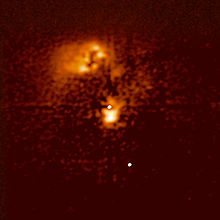Dark galaxy
A dark galaxy is a galaxy whose mass largely consists of non-self-luminous matter and therefore contains very few or no stars . Hence the suffix "dark".
The galaxy could contain gas , cosmic dust, and dark matter . Several objects were suspected to be a dark galaxy, but some were later refuted.
Candidates
Dragonfly 44
Dragonfly 44 is a galaxy in the constellation Haar der Berenike , which has about the mass of the Milky Way . It consists of 99.9% dark matter. Their discovery was announced in June 2016.
HE0450-2958
HE0450-2958 is an unusual quasar with no galaxy being found around it. It was suggested that this could be a dark galaxy in which a quasar was active.
HVC 127-41-330
HVC 127-41-330 is a high speed cloud around M31 and M33 .
VIRGOHI21
The discovery of VIRGOHI21 was announced in February 2005. It was found while looking for radio waves caused by hydrogen .
In the Coma galaxy cluster
In mid-2015, the discovery of over 800 dark galaxies in the Coma galaxy cluster was published.
literature
- Stuart Clark: Astronomers claim first 'dark galaxy' find . In: NewScientist.com news service , February 23, 2005. Retrieved June 1, 2007.
- David Shiga: Ghostly Galaxy: Massive, dark cloud intrigues scientists . In: Science News Online . 167, No. 9, February 26, 2005, p. 131. Retrieved October 26, 2006.
Web links
- scinexx .de: Dark galaxies tracked May 24, 2018.
Individual evidence
- ↑ Article about Dragonfly 44 , accessed August 26, 2016
- ↑ Pieter van Dokkum, Roberto Abraham, Jean Brodie, Charlie Conroy, Shany Danieli, Allison Merritt, Lamiya Mowla, Aaron Romanowsky, Jielai Zhang: A High Stellar Velocity Dispersion and ~ 100 Globular Clusters for the Ultra Diffuse Galaxy Dragonfly 44 , arxiv : 1606.06291
- ↑ Jin Koda, Masafumi Yagi, Hitomi Yamanoi, Yutaka Komiyama: Approximately A Thousand Ultra Diffuse Galaxies in the Coma cluster. Astrophysical Journal Letters, 2015; arxiv : 1506.01712
- ↑ Astronomers discover "dark galaxies". Mysterious clusters of stars are likely made almost entirely of dark matter
